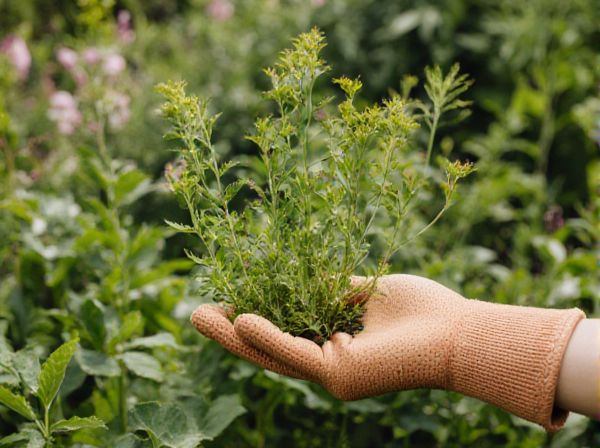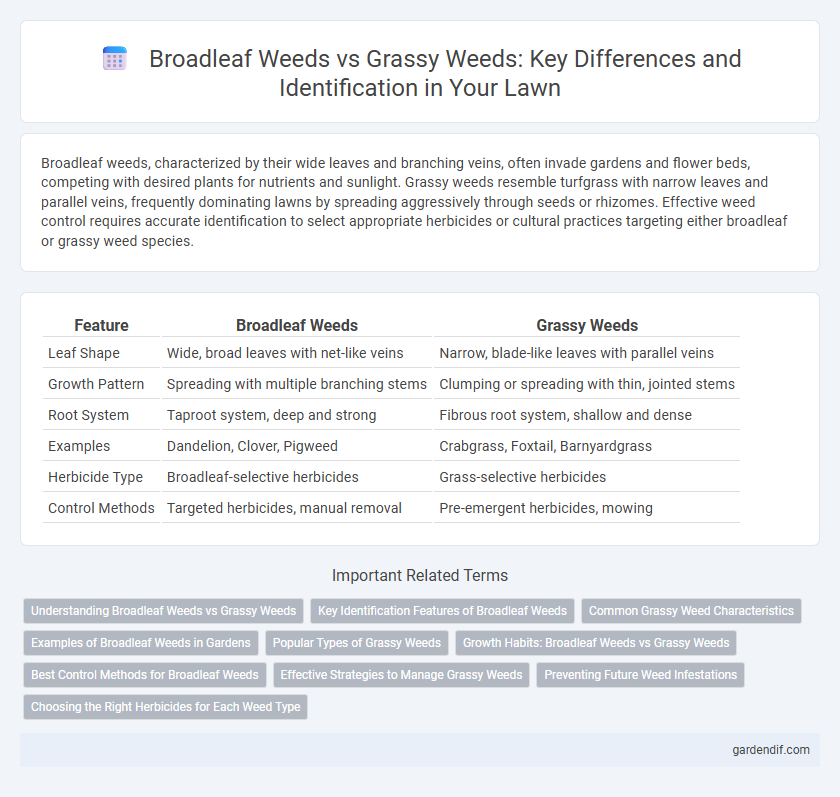
Broadleaf weeds vs grassy weeds Illustration
Broadleaf weeds, characterized by their wide leaves and branching veins, often invade gardens and flower beds, competing with desired plants for nutrients and sunlight. Grassy weeds resemble turfgrass with narrow leaves and parallel veins, frequently dominating lawns by spreading aggressively through seeds or rhizomes. Effective weed control requires accurate identification to select appropriate herbicides or cultural practices targeting either broadleaf or grassy weed species.
Table of Comparison
| Feature | Broadleaf Weeds | Grassy Weeds |
|---|---|---|
| Leaf Shape | Wide, broad leaves with net-like veins | Narrow, blade-like leaves with parallel veins |
| Growth Pattern | Spreading with multiple branching stems | Clumping or spreading with thin, jointed stems |
| Root System | Taproot system, deep and strong | Fibrous root system, shallow and dense |
| Examples | Dandelion, Clover, Pigweed | Crabgrass, Foxtail, Barnyardgrass |
| Herbicide Type | Broadleaf-selective herbicides | Grass-selective herbicides |
| Control Methods | Targeted herbicides, manual removal | Pre-emergent herbicides, mowing |
Understanding Broadleaf Weeds vs Grassy Weeds
Broadleaf weeds, such as dandelions and clover, have wide, flat leaves with net-like veins, while grassy weeds like crabgrass and barnyardgrass feature narrow, blade-like leaves with parallel veins. Identifying these differences is crucial for targeted weed control strategies, as broadleaf herbicides selectively eliminate broadleaf weeds without harming lawn grasses, whereas grassy weed control requires different herbicides or cultural practices. Effective weed management depends on recognizing the structural and biological traits of broadleaf versus grassy weeds to implement appropriate treatment methods.
Key Identification Features of Broadleaf Weeds
Broadleaf weeds are identified by their wide, flat leaves with net-like veins, contrasting with the narrow, parallel-veined leaves of grassy weeds. These weeds often have distinct petioles and branching leaf structures, while grassy weeds display slender, blade-like foliage. Recognizing broadleaf weeds also involves noting their floral characteristics, which are typically more elaborate than the inconspicuous flowers of grassy weeds.
Common Grassy Weed Characteristics
Common grassy weeds typically feature narrow, blade-like leaves with parallel veins and grow in clumps or tufts, often spreading through seeds or rhizomes. These weeds possess fibrous root systems, making them more resilient in lawns and turf areas compared to broadleaf weeds. Understanding the growth patterns and leaf structure of grassy weeds aids in selecting effective herbicides and management strategies for weed control.
Examples of Broadleaf Weeds in Gardens
Broadleaf weeds commonly found in gardens include dandelions, clover, and plantain, which feature wide leaves and often vibrant flowers. These broadleaf varieties differ from grassy weeds by their broad, flat leaves and distinct vein patterns. Controlling broadleaf weeds such as chickweed, bindweed, and creeping Charlie requires targeted herbicides or manual removal to protect garden plants.
Popular Types of Grassy Weeds
Popular types of grassy weeds include crabgrass, foxtail, and bluegrass, which commonly invade lawns and gardens, competing with desirable turfgrass for nutrients, water, and sunlight. These grassy weeds are characterized by narrow leaves with parallel veins and grow in tufts or clumps, making them distinguishable from broadleaf weeds with wider leaves and net-like veins. Effective control of grassy weeds often requires targeted herbicides and proper lawn maintenance practices such as mowing, aeration, and fertilization to promote healthy grass growth and reduce weed establishment.
Growth Habits: Broadleaf Weeds vs Grassy Weeds
Broadleaf weeds exhibit a spreading growth habit with broad, flat leaves and often thrive in diverse environments, competing aggressively for nutrients and sunlight. Grassy weeds possess narrow, blade-like leaves and tend to grow in dense clumps or mats, often mimicking turfgrass, making identification and control more challenging. Understanding these growth habits is essential for selecting effective weed management strategies tailored to the specific type of weed infestation.
Best Control Methods for Broadleaf Weeds
Effective control of broadleaf weeds involves selective herbicides that target dicot plants without harming grasses, such as 2,4-D, dicamba, or triclopyr. Mechanical methods like hand-pulling and mowing help reduce seed spread, while cultural practices including maintaining dense turf and proper fertilization improve lawn health and suppress weed growth. Integrated weed management combining chemical, mechanical, and cultural techniques offers the best long-term control of broadleaf weeds in turf and garden settings.
Effective Strategies to Manage Grassy Weeds
Grassy weeds such as crabgrass and foxtail compete aggressively with turfgrass, necessitating targeted management strategies for effective control. Utilizing pre-emergent herbicides timed before weed seed germination, combined with post-emergent treatments on actively growing weeds, enhances long-term turf health. Implementing cultural practices like proper mowing height, adequate irrigation, and soil aeration further suppresses grassy weed proliferation and promotes dense, competitive turfstands.
Preventing Future Weed Infestations
Preventing future weed infestations requires understanding the difference between broadleaf and grassy weeds, as they demand distinct management approaches. Broadleaf weeds, characterized by their wide, flat leaves, often thrive in nutrient-rich soils and can be controlled through targeted herbicides and regular mulching. Grassy weeds, which resemble turfgrass, spread rapidly via seeds and rhizomes, making frequent mowing, proper lawn aeration, and selective grassy weed killers essential for effective prevention.
Choosing the Right Herbicides for Each Weed Type
Broadleaf weeds like dandelions and clover respond best to selective herbicides containing 2,4-D or dicamba, which target their broad leaves without damaging grass. Grassy weeds such as crabgrass and foxtail require pre-emergent or post-emergent herbicides with active ingredients like quinclorac or sethoxydim, designed to inhibit grass growth. Accurate identification of the weed type ensures the effective selection of herbicides, optimizing control while preserving desirable plants.
Broadleaf weeds vs grassy weeds Infographic

 gardendif.com
gardendif.com